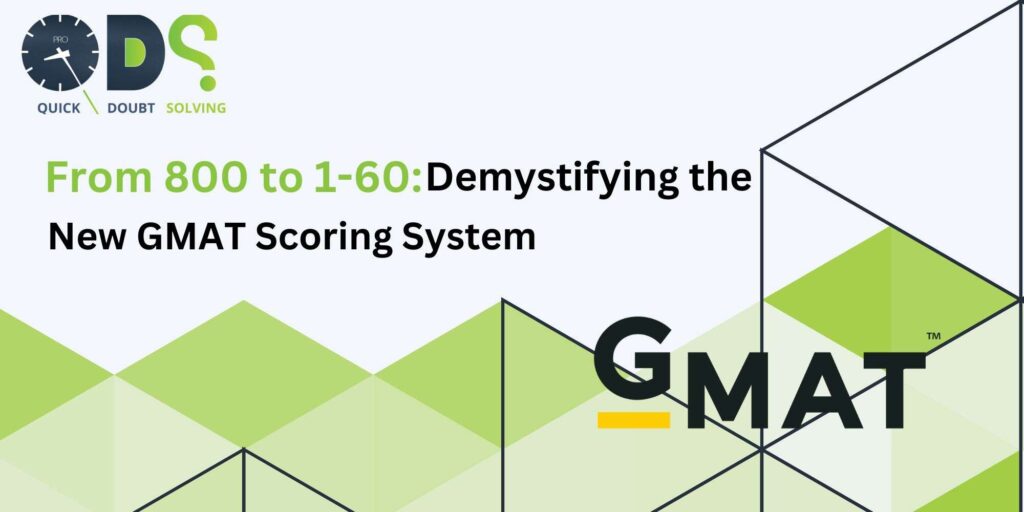Introduction To New GMAT Scoring System
New GMAT Scoring System: Are you getting ready for the GMAT and finding the latest changes to the scoring system confusing?
Don’t Panic! The new GMAT score system, which goes from 800 to 1 – 60, may appear less intimidating now that QDS Pro is available. Let’s explore the nuances of this change. Comprehend how to properly evaluate results, and deal with any issues regarding score comparisons with the previous method.

The Evolution of the Scoring System
For many years, the Graduate Management Admission Test (GMAT) served as a standard for assessing applicants’ preparedness for business school. In the past, performance on the Verbal Reasoning, Quantitative Reasoning, Integrated Reasoning, and Analytical Writing Assessment (AWA) parts was measured using an 800-point scale.
However, the Graduate Management Admission Council, or GMAC, has adopted a more thorough 1 – 60 scoring system with the launch of QDS Pro. With the help of this new approach, candidates’ talents may be evaluated more carefully. Giving business schools a deeper understanding of their strong points and potential areas for development.
Deciphering the New Scale
It is possible that test-takers will initially become confused by the switch to the 1 – 60 scale. However, the procedure made less mysterious by comprehending the fundamental ideas. A scaled score between 1 and 60 assigned to each GMAT section, enabling accurate performance evaluation.
As the key measure of a candidate’s overall performance, the total score, which goes from 200 to 800, is still of importance. Additionally, the section scores provide insightful information on certain talents, like verbal reasoning, data interpretation, numeric competency, and analytical writing skills.
Interpreting Scores with Precision: New GMAT Scoring System
Prospective MBA candidates must understand how to analyze their GMAT results. A more complex approach to score analysis required with the shift to the 1 – 60 scale. Candidates should examine their individual section results rather than just the overall score to determine their areas of strength and potential growth.
A candidate’s propensity for numerical analysis may be indicated, for example, by a high score in quantitative reasoning combined with a low verbal reasoning score, although language comprehension and critical thinking skills may still require improvement. Analogously, the Integrated Reasoning segment evaluates applicants’ capacity to integrate data from several sources and provides an understanding of their data interpretation abilities.
Additionally, the AWA score indicates how well applicants can communicate in writing, giving admissions committees important information about their capacity for critical thought and clear articulation.
Addressing Concerns and Comparing Scores
The difficulty of comparing scores to the previous system is one of the main issues with the switch to the new scoring system. Many candidates, particularly those assessing their eligibility for particular business schools, are curious about how their performance on the 1 – 60 scale compares to the prior 200-800 scale.
QDS Pro provides conversion tools and recommendations to ease score comparisons between the old and new systems to solve this difficulty. The changes recognized by admissions committees, take into account candidates’ scores in light of the revised scale.
Additionally, business schools place a high value on a comprehensive assessment of applicants that takes into account variables other than test results. Important components of the admissions process include work experience, academic background, extracurricular activities, and reference letters. Which enables colleges to evaluate applicants thoroughly.
Conclusion: Embracing the Transition
The transition of the GMAT scoring system from 800 to 1 – 60 marks the beginning of a new era. It gives applicants a new scale to learn, but it also provides a more thorough and nuanced assessment of their skills.
Prospective MBA students may confidently navigate the admissions process by learning how to evaluate scores and using tools like QDS Pro.
To achieve your academic and professional goals, rise to the challenge, maintain focus, and realize your full potential.
You can also read GMAT Focus Edition



